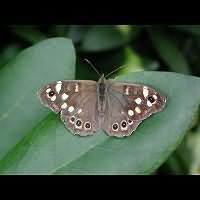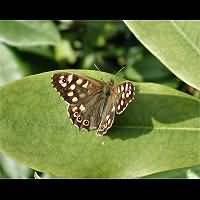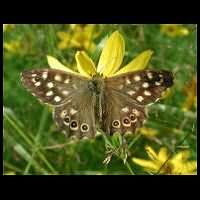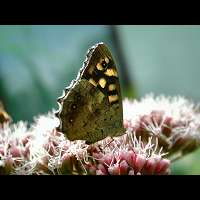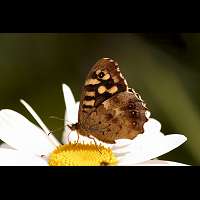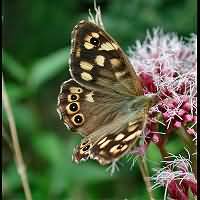Speckled Wood Pararge aegeria
Our garden has sandy soil and is situated very close to forests. Therefore some wood nymphs are also frequent visitors in it. One of them is the Speckled Wood. Even though it has a much livelier design than the Ringlet, it is still a rather dull, brownish butterfly that is often overlooked. It is not very easy to tell males and females apart, except if you know what to look for. Both sexes have eye-shaped spots on the upperside of the hindwings. Males have four of these spots, while females only have three. However all three spots of the females show a white nucleus and look like eyes. In males only two of the spots have a white nucleus, the other two are simply black blobs. The 'eye' that can be seen on the front wing has a bigger white area (actually often consisting of three smaller spots) around them than they do in males. The animal in the top picture is a male and the animal in the picture second from the top is a female.
In and near woodlands the Speckled Wood is a common species in Britain. When it does live near you, you'll have a lot of opportunities meeting it, for it flies for the greater part of the year. In southern parts of Britain it produces three broods flying from March till the end of October. Up north only two broods occur or, even further north, only one, drastically shortening the flying period. On the continent the Speckled Wood is a very common butterfly as well, except for Northern Scandinavia where it is absent. The species however has two colour variations: in Britain, Northern France, the Benelux, Germany, the Balkans and Turkey the light patches in the wing have a creamy colour. This variation is called Pararge aegeria tircis. In the south of France, Spain, Portugal, Italy and Northern Africa the light patches are bright orange, even tending to red going southwards. This subspecies is considered to be the standard and thus is called Pararge aegeria aegeria.
Reaching a wingspan of some 42 mm the Speckled Wood is about the same size as the Ringlet. The caterpillar is green and covered with numerous short white hairs. It, like the Ringlet's caterpillar feeds on various grasses. The species is remarkable, for it may not only overwinter in the larval stage, but as pupa as well, quite unusual in butterflies. This explains the long period it flies about. One frequently sees more than one female flying about. Males are not seen that often, for they occupy a territory. In this territory females are allowed to fly in and out, but other males are chased away immediately. So while the females suck on flowers, the male owner of the territory either keeps watch or is busy chasing away other males!
Our garden has sandy soil and is situated very close to forests. Therefore some wood nymphs are also frequent visitors in it. One of them is the Speckled Wood. Even though it has a much livelier design than the Ringlet, it is still a rather dull, brownish butterfly that is often overlooked. It is not very easy to tell males and females apart, except if you know what to look for. Both sexes have eye-shaped spots on the upperside of the hindwings. Males have four of these spots, while females only have three. However all three spots of the females show a white nucleus and look like eyes. In males only two of the spots have a white nucleus, the other two are simply black blobs. The 'eye' that can be seen on the front wing has a bigger white area (actually often consisting of three smaller spots) around them than they do in males. The animal in the top picture is a male and the animal in the picture second from the top is a female.
In and near woodlands the Speckled Wood is a common species in Britain. When it does live near you, you'll have a lot of opportunities meeting it, for it flies for the greater part of the year. In southern parts of Britain it produces three broods flying from March till the end of October. Up north only two broods occur or, even further north, only one, drastically shortening the flying period. On the continent the Speckled Wood is a very common butterfly as well, except for Northern Scandinavia where it is absent. The species however has two colour variations: in Britain, Northern France, the Benelux, Germany, the Balkans and Turkey the light patches in the wing have a creamy colour. This variation is called Pararge aegeria tircis. In the south of France, Spain, Portugal, Italy and Northern Africa the light patches are bright orange, even tending to red going southwards. This subspecies is considered to be the standard and thus is called Pararge aegeria aegeria.
Reaching a wingspan of some 42 mm the Speckled Wood is about the same size as the Ringlet. The caterpillar is green and covered with numerous short white hairs. It, like the Ringlet's caterpillar feeds on various grasses. The species is remarkable, for it may not only overwinter in the larval stage, but as pupa as well, quite unusual in butterflies. This explains the long period it flies about. One frequently sees more than one female flying about. Males are not seen that often, for they occupy a territory. In this territory females are allowed to fly in and out, but other males are chased away immediately. So while the females suck on flowers, the male owner of the territory either keeps watch or is busy chasing away other males!

